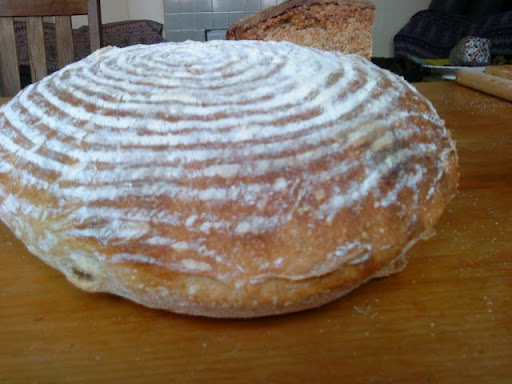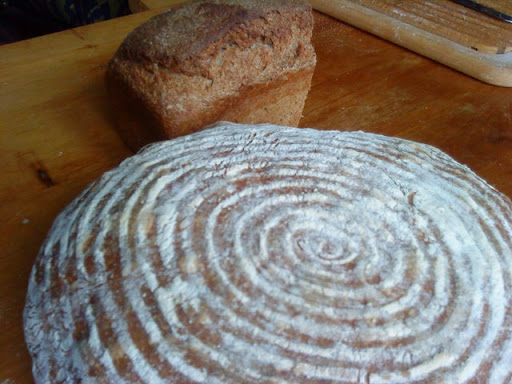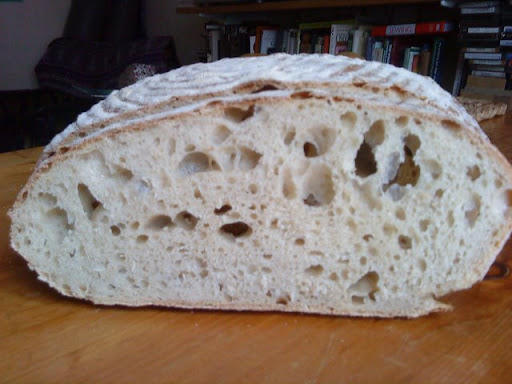Can't really share the recipe because it was a complete mixture of some pizza dough left over in the freezer, some sourdough starter in the fridge and a mixture of plain and strong white flour. Anyway it turned out nicely.
Bread Making.
-
grahamhobbs
- A selfsufficientish Regular

- Posts: 1212
- Joined: Mon Aug 10, 2009 4:39 pm
- Location: London
Re: Bread Making.
Well, Julie, I don't normally bake white bread, we prefer wholemeal usually (in the background of one pic), but your post spurred me into baking some white bread.
Can't really share the recipe because it was a complete mixture of some pizza dough left over in the freezer, some sourdough starter in the fridge and a mixture of plain and strong white flour. Anyway it turned out nicely.



Can't really share the recipe because it was a complete mixture of some pizza dough left over in the freezer, some sourdough starter in the fridge and a mixture of plain and strong white flour. Anyway it turned out nicely.
Re: Bread Making.
Graham, how did youmake the magic swirly patterns? ! it looks so pretty!
-
grahamhobbs
- A selfsufficientish Regular

- Posts: 1212
- Joined: Mon Aug 10, 2009 4:39 pm
- Location: London
Re: Bread Making.
Simple really, its left to prove in a cane basket, formed like a spiral, that is floured to prevent the dough sticking. When its turned out, it comes out with the floured rings.
-
grahamhobbs
- A selfsufficientish Regular

- Posts: 1212
- Joined: Mon Aug 10, 2009 4:39 pm
- Location: London
Re: Bread Making.
I've never tried baking bread using plain wholemeal flour. Although white plain flour is ok, as long as you give it a long fermentation and has the advantage of better flavour over strong white flour, I imagine using plain wholemeal flour will be very difficult and the taste difference less noticeable. Has anyone tried using plain wholemeal flour?
- Millymollymandy
- A selfsufficientish Regular

- Posts: 17637
- Joined: Tue May 10, 2005 6:09 am
- Location: Brittany, France
Re: Bread Making.
Yes, because bread flour only arrived in France about 3-4 years ago. It wasn't wholemeal but just brown flour as that's all you can get here in a supermarket and only from one brand! Just as cake like as plain white flour or any bread flours when made my hand by me. 
http://chateaumoorhen.blogspot.com/boboff wrote:Oh and just for MMM,(thanks)
-
grahamhobbs
- A selfsufficientish Regular

- Posts: 1212
- Joined: Mon Aug 10, 2009 4:39 pm
- Location: London
Re: Bread Making.
MMM, I thought they always sold bread flour in France, called '55' (?), as against '45' for pastry, and a flour for pain de campagne which was a mix of white and a little rye (perhaps some wholemeal as well). At least they did do in the Touraine. Brown flour is usually just coloured white flour, not really wholemeal at all. But you are right french flours are no where near as strong as 'english' strong bread flour.
- Millymollymandy
- A selfsufficientish Regular

- Posts: 17637
- Joined: Tue May 10, 2005 6:09 am
- Location: Brittany, France
Re: Bread Making.
Graham, type 55 flour is just general purpose plain flour. They sell type 45 which is supposed to be for 'patisserie' but 55 is better. Type 80 is grey flour and Type 100 slightly brown Type 150 is more brown, you might call it wholemeal but if you sieve it there are no 'bits' that don't go through the sieve, but neither 100 nor 150 are sold in the shops. The numbers just refer to the amount the flour has been refined.
None of them are strong bread flours. Just various different shades of plain flour.
Don't forget this is the country of the boulangerie and home bread making has only just started taking off in France in the last few years with the advent of breadmakers and strong bread flour!
Now you can buy bread flours and they are exactly the same as English bread flours, only they tend to come in white, white brioche or white with grains. So I buy a Belgian brand of real wholemeal bread flour with bits in from the garden centre.
None of them are strong bread flours. Just various different shades of plain flour.
Don't forget this is the country of the boulangerie and home bread making has only just started taking off in France in the last few years with the advent of breadmakers and strong bread flour!
Now you can buy bread flours and they are exactly the same as English bread flours, only they tend to come in white, white brioche or white with grains. So I buy a Belgian brand of real wholemeal bread flour with bits in from the garden centre.
http://chateaumoorhen.blogspot.com/boboff wrote:Oh and just for MMM,(thanks)
-
JillStephens7
- Living the good life

- Posts: 399
- Joined: Mon Jul 06, 2009 7:13 pm
- Location: Halton, near Lancaster
Re: Bread Making.
Millymollymandy wrote: I buy a Belgian brand of real wholemeal bread flour with bits in from the garden centre.
-
JillStephens7
- Living the good life

- Posts: 399
- Joined: Mon Jul 06, 2009 7:13 pm
- Location: Halton, near Lancaster
Re: Bread Making.
Hello, now I'm wondering if this long rise method applies to pizza dough too? Can anyone tell me how they do their please?
The bread I'm making now is so much nicer than I've made before I'm betting someone out there has a sooooper pizza base technique they might be kind enough to share?
Pretty please?
x
The bread I'm making now is so much nicer than I've made before I'm betting someone out there has a sooooper pizza base technique they might be kind enough to share?
Pretty please?
x
- Millymollymandy
- A selfsufficientish Regular

- Posts: 17637
- Joined: Tue May 10, 2005 6:09 am
- Location: Brittany, France
Re: Bread Making.
OK it all comes from the garden centre, not just the bits.JillStephens7 wrote:Millymollymandy wrote: I buy a Belgian brand of real wholemeal bread flour with bits in from the garden centre.





http://chateaumoorhen.blogspot.com/boboff wrote:Oh and just for MMM,(thanks)
-
JillStephens7
- Living the good life

- Posts: 399
- Joined: Mon Jul 06, 2009 7:13 pm
- Location: Halton, near Lancaster
Re: Bread Making.
Ah, I see 
Still laughing out loud about this ... really must get out more
Still laughing out loud about this ... really must get out more
-
grahamhobbs
- A selfsufficientish Regular

- Posts: 1212
- Joined: Mon Aug 10, 2009 4:39 pm
- Location: London
Re: Bread Making.
Jill, if you are making good bread then you can make good pizza dough. Good flavour, in any bread dough, is primarily through using a long fermentation method using small amounts of yeast, secondly using a tasty flour (I find strong white bread flour rather metallic so prefer to mix it with plain flour and perhaps a bit of wholemeal) and perhaps keeping the dough in the fridge overnight.
You will need approx. 150g of flour per pizza.
To get that long fermentation, I'd suggest making a 'poolish', a kind of batter, this is a mix of part of the flour with an equal weight of water and a pinch of dried yeast, no salt. Mix and leave covered until the following day (probably 12 to 16 hours), by which time it should be covered in bubbles. Add 1 to 2 times the weight of flour initially added but proportionally less water (You are aiming for flour to water ratio of 100 to 70 by weight, so you need to calculate this eg. if you started with 300g flour and 300g water and you need to make 4 pizzas, then you need to add 300g flour and only 120g water. For 6 pizzas it would be an extra 600g flour and 330g water).
You can add a dash of olive oil if you like, I usually do. Mix and knead lightly until its well mixed. Leave for at least 30 minutes and then add the salt, I find about 1.5 level teaspoons is about right for 1kg total weight of flour and water. Knead again, you should find it a lot easier now (after that 30mins rest), knead until the dough is such that if you stretch a small piece it forms a small opaque window without tearing.
Leave in a covered bowl to rise for probably about 4 hours, this depends a lot on the temperature of the room. Cooler temperatures will produce better tasting doughs. (The important thing is not to let the dough overprove, this is when the dough collapses if you touch it, so keep an eye on it. It is risen when it is nicely domed, has small bubbles on the surface and if you poke it the hole doesn't close up quickly). You can put the dough in the fridge at any time, before, during or after it has risen, for up to a day or so. Obviously if you put it in the fridge it will take time to come back to room temperature and if it hadn't fully risen beforehand, to rise fully.
Then divide up the dough to make your pizzas in the normal way, each weighing approx 250g. Best to form into tight balls like you would for rolls, leave covered to rest for approx 20mins to relax, then form into the pizza shape. Bake in a very hot oven on a pre-heated hearth stone.
You can put any left over dough into the freezer to use another time or you can use it to start the next batch in lieu of the poolish, just remembering to adjust the water and salt accordingly.
If the poolish method seems too complicated, you can just make the dough in one go and then put in the fridge over night, just doing this will improve the flavour of the dough.
Hopefully I've explained things sufficiently, but get back to me if I haven't explained anything clearly
You will need approx. 150g of flour per pizza.
To get that long fermentation, I'd suggest making a 'poolish', a kind of batter, this is a mix of part of the flour with an equal weight of water and a pinch of dried yeast, no salt. Mix and leave covered until the following day (probably 12 to 16 hours), by which time it should be covered in bubbles. Add 1 to 2 times the weight of flour initially added but proportionally less water (You are aiming for flour to water ratio of 100 to 70 by weight, so you need to calculate this eg. if you started with 300g flour and 300g water and you need to make 4 pizzas, then you need to add 300g flour and only 120g water. For 6 pizzas it would be an extra 600g flour and 330g water).
You can add a dash of olive oil if you like, I usually do. Mix and knead lightly until its well mixed. Leave for at least 30 minutes and then add the salt, I find about 1.5 level teaspoons is about right for 1kg total weight of flour and water. Knead again, you should find it a lot easier now (after that 30mins rest), knead until the dough is such that if you stretch a small piece it forms a small opaque window without tearing.
Leave in a covered bowl to rise for probably about 4 hours, this depends a lot on the temperature of the room. Cooler temperatures will produce better tasting doughs. (The important thing is not to let the dough overprove, this is when the dough collapses if you touch it, so keep an eye on it. It is risen when it is nicely domed, has small bubbles on the surface and if you poke it the hole doesn't close up quickly). You can put the dough in the fridge at any time, before, during or after it has risen, for up to a day or so. Obviously if you put it in the fridge it will take time to come back to room temperature and if it hadn't fully risen beforehand, to rise fully.
Then divide up the dough to make your pizzas in the normal way, each weighing approx 250g. Best to form into tight balls like you would for rolls, leave covered to rest for approx 20mins to relax, then form into the pizza shape. Bake in a very hot oven on a pre-heated hearth stone.
You can put any left over dough into the freezer to use another time or you can use it to start the next batch in lieu of the poolish, just remembering to adjust the water and salt accordingly.
If the poolish method seems too complicated, you can just make the dough in one go and then put in the fridge over night, just doing this will improve the flavour of the dough.
Hopefully I've explained things sufficiently, but get back to me if I haven't explained anything clearly
Last edited by grahamhobbs on Mon Apr 12, 2010 12:45 pm, edited 1 time in total.
-
JillStephens7
- Living the good life

- Posts: 399
- Joined: Mon Jul 06, 2009 7:13 pm
- Location: Halton, near Lancaster
Re: Bread Making.
Woo-hooooooooo!grahamhobbs wrote:if you are making good bread then you can make good pizza dough.
Can't say I've taken the rest of it in yet, takes me a while to get my head round things but thanks a billion for your efforts Graham, once it's all sunk in (a few weeks and several re-reads probably), looks like it'll be margheritas all round. Heck maybe even margaritas all round if it comes off as well as the bread
Thanks again, much appreciated, Jill
-
JillStephens7
- Living the good life

- Posts: 399
- Joined: Mon Jul 06, 2009 7:13 pm
- Location: Halton, near Lancaster
Re: Bread Making.
Well, that's my first pizza using the poolish method polished off and very tasty it was too.
I messed up my calculations a bit (forgot to include the water added at the beginning when calculating the water to flour ratio) but was so obviously way out I put some extra flour in til it was kneadable. Not perfect but certainly very tasty. Can only get better from here.
Thanks again Graham
My main concern now, having just finished my lunch is what I'm going to make for tea
is what I'm going to make for tea  eek!
eek!
I messed up my calculations a bit (forgot to include the water added at the beginning when calculating the water to flour ratio) but was so obviously way out I put some extra flour in til it was kneadable. Not perfect but certainly very tasty. Can only get better from here.
Thanks again Graham
My main concern now, having just finished my lunch
- JulieSherris
- A selfsufficientish Regular

- Posts: 1608
- Joined: Sat Jul 19, 2008 11:12 pm
- Location: Co Galway, ROI.
Re: Bread Making.
The more people I meet, the more I like my garden 